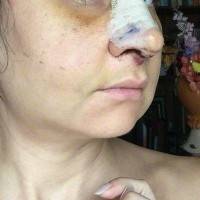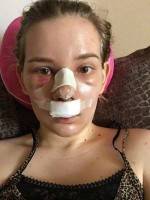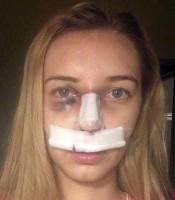Rhinoplasty Recovery Faq
After a rhinoplasty, you are generally off of narcotic pain medicine and feeling well by 1-2 days after surgery. Your nasal cast will come off at about 1 week after surgery.
Bruising around the eyes will clear up by 1-2 weeks after surgery in most cases. You will feel well enough to return to work or school within 1 week, although you will still have some swelling at this time.
After several months, most swelling will disappear, but it takes nearly a year for the final result of a rhinoplasty to be evident. (Lara Devgan, MD, MPH, New York Plastic Surgeon)
To help control bruising, swelling, and minor bleeding, you will spend the first day after surgery at home in bed with your head elevated. The majority of bruising will be be gone in one to two weeks. For the first few days, you should continue to sleep with your head elevated and apply cold compresses to reduce swelling.
You will need to refrain from taking aspirin and any anti-inflammatory drugs that can increase bleeding. In addition, avoid rubbing or hitting the nose 8 weeks following surgery and sun exposure should be limited for two months.
Most patients can return to work in 7-10 days following surgery. (Henry Mentz, MD, Houston Facial Plastic Surgeon)
Rhinoplasty Recovery
Recovery from rhinoplasty will depend on the the individual and complexity of the rhinoplasty. Most patients will be up and about the following day. You can expect to be on pain medications for at least a few days, but up to a week. It is common for the nose to be noticeably swollen for up to 2 weeks.
After this period of time, there is minor residual swelling that can take up to a year to resolve, but you are about the only person that will notice the subtle changes over this period of time.
You can expect nasal congestion from swelling to last for 2-4 weeks. If the nasal bones are broken, you will likely get black eyes for 1-2 weeks. If the nasal bones don’t need to be broken, then it is unusual to get black eyes.
I advise my patients to avoid strenuous activity or heavy lifting for 2 weeks from the time of surgery. I also advise my patients against activities that they may bump their nose for a total of 6 weeks from the time of surgery. (Sirius K. Yoo, MD, San Diego Facial Plastic Surgeon)
Rhinoplasty Recovery and Healing
Recovery from rhinoplasty, like any surgery, is highly individualized depending on the intensity of the procedure, patient’s overall health, state-of-mind, healing ability as well as other factors. When will you go home? Most patients go home the day of the procedure with a designated caregiver as you will not be able to drive.
How will I feel right after? You may feel woozy and sleepy, but that should wear off rather quickly. Patients can experience some dull aches, bruising and swelling, for which some patients choose to take mild pain medication.
The swelling causes congestion, which can make it hard to breathe. Some patients describe the feeling as having a cold. What can’t I do after surgery? For the first three weeks or so after surgery, you should not participate in any activity that elevates your heart-rate. You should also avoid any contact sport for at least 6 weeks to ensure that the cartilage is properly healed and set in place.
This includes exercise as well as stress. Although congestions can be irritating, it is imperative that you don’t rub your nose as that can shift cartilage and restructure it. How long will it take to get back to normal?
Most patients report seeing their full results, without swelling, at approximately two months. However, that can vary greatly depending on the individual. Most importantly, follow up with your plastic surgeon as scheduled to ensure that your recovery is on track! (Jennifer Levine, MD, New York Facial Plastic Surgeon)
A typical recovery from rhinoplasty would be one day for packing to be removed from the nose. One week until I take the external splint off and sutures out. This is the time you could go back to work. About half of the swelling is gone after one month, but the other half of the swelling takes the next eleven months to go completely away. If there is bruising under the eyes, this could take two to four weeks to completely resolve.
I permit most patients to start back to strenuouse exercise two weeks after their surgery. I encourage my patients to do plenty of walking starting the day after surgery. (Stephan Finical, MD, Charlotte Plastic Surgeon)
Rhinoplasty surgery is one of the easiest procedures to recover from. After surgery tape and splint are applied to the nose for a period of 7 to 10 days, the nose is then taped for an additional week.
I do not pack the nose but if septum is worked on then a splint is applied that allows patients to breath through the nose after surgery, and unlike packing it is easily removed.
Patient can return to a desk job after 3 to 5 days if wearing a splint at work is acceptable. There will be bruising under the eyes if nasal bones are repositioned. Pain is easily controlled and is usually minimal. However full activity and sports are 4 to 6 weeks out. (Shahriar Mabourakh, MD, FACS, Sacramento Plastic Surgeon)
I recommend my patients at least 1 week but if you can take 2 that would great also, the more time you have to recover and rest the better.
After being discharged you leave with a cast on the nose which you have one for 1 week also you would be rather swollen in the face there would be bruising and puffiness in the eye area, I ask my patients to come back in 1 week for your follow-up where we would remove your cast and I put a tape which you wear fro 2 weeks and afterwards you would come back for another follow-up i remove the tape and you do not have to wear anything.
It is important that throughout this whole recovery process you limit yourself to a lot of activities to avoid any harm to your nose.
During the followups is where depending on how you are recovering you would be permitted to return to some of your regular activites but all in all you need 1 week and just to be very careful with any sudden movements of just anything that could ruin your surgery.
Swelling starts to subside between the 3rd and 4th week after surgery usually but each patient is very different sometimes the patient can unswell before that time period or viceversa, final results are seen until 6 months after surgery. (Luis Suarez, MD, Mexico Plastic Surgeon)
Rhinoplasty surgery recovery timeline
The healing process following rhinoplasty surgery is unique to each individual. In general, you can expect swelling and bruising for about one week after your procedure. Most patients return to work in a week once the stitches and splint are removed. By this time much of the swelling has subsided and any residual bruising can be covered up with makeup. (Robert Morin, MD, New York Plastic Surgeon)
Rhinoplasty surgery recovery: What is the Downtime for a Nose Job?
This is a fairly common question when we are talking to patients about a rhinoplasty surgery. If we define recovery as being able to go out in public then rhinoplasty surgery recovery is about 2 to 3 days or as soon as the splint comes off. With a rapid recovery program, and operative techniques designed to minimize swelling and bruising you should do very well after the surgery except the splint does not look very good.
Most people think that the splint is to keep the bones in place but it is really for reducing swelling and preventing the collection of blood under the skin. Therefore there is little need to keep the splint on any longer than about 2 to 3 days. Once it is off then, with a little makeup, you should reason able and be recovered. There is little pain from this surgery and most patients simply use anti-inflammatories rather than narcotics. You are not healed so this discomfort can go on for a week or two as well as some stuffiness form the swelling inside your nose but you are recovered. (Brian Windle, MD, Kirkland Plastic Surgeon)
Typically, I prefer rhinoplasty patients to wear a splint over their nose for 1 week following the surgery. Depending on the nature of the surgery, I also sometimes place packing in the nose immediately post-surgery with a “drip pad” taped below the nostrils.
Although it’s tempting, it’s not wise to remove this packing until your surgeon tells you it’s ok (usually 2-3 days) – it’s there for a reason and it’s often helping to promote healing of the interior of the nose.
Once the outer splint is removed after a week, there is some residual swelling around the nose and often bruising under the eyes.
Bruising under the eyes occurs, most commonly, if there is any adjustment to the shape or contours of the bony framework of the nose. If bony adjustments are not required, bruising under the eyes generally does not occur.
Any bruising at this point is usually easily covered by makeup and will likely be gone within another week. In terms of contour and shape of the nose, you will likely be very pleased almost immediately after the splint comes off, however, a true sense of what you can expect from the final result will not be obvious for about a month after surgery.
The healing then continues to take place over the next 12-18 months. However, after 6 months, the changes are quite subtle. During the first few months of healing time, it is important not to bump your nose, since any changes or repair will not have completely healed yet.
I often give the splint back to the patient after it is removed to be worn for the next 2-3 weeks at night and/or during any contact sports – as a reminder that the nose is not yet healed.
It’s also important not to wear sunglasses for at least 4-6 weeks as sunglasses sit right on the bridge of the nose and often slide down the tip as well so they can definitely negatively impact healing.
I’d say that if you really need sunglasses for driving, then put the splint on and then have the sunglasses rest on the splint…but maybe wearing a hat with a brim to shield your eyes from the sun is a better choice.
In terms of going back to work, you can go back to work with the splint on within 2-3 days post-surgery. If you would prefer that nobody knows you had this surgery, I would suggest planning for a 7-10 day period off work. (Michael R. Macdonald, MD, Bay Area Facial Plastic Surgeon)
Recovery after rhinoplasty procedure
Following rhinoplasty procedure, I tell most patients to expect taking one week off of work or school. Although many of my patients do not develop any significant bruising, bruising usually is not very noticeable after the first week.
But to be honest, recovery after a rhinoplasty procedure is a much longer process. What I am referring to is the resolution of the post-surgical swelling.
This can vary greatly from patient to patient, but the nose will continue to refine over many months and years. These changes can be extremely subtle, but trust me, they are occurring.
The good news is that the vast majority of patients are pleased with their result throughout this extended recovery period. This is why I follow my patients on a very regular basis following a rhinoplasty procedure. (Ryan Greene, MD, PhD, Fort Lauderdale Facial Plastic Surgeon)
Typically you can return to work about a week later, however the swelling and bruising takes a bit longer to subside. Normally after 2 weeks much of the swelling and bruising has subsided. There is still residual swelling that takes a bit longer to go away but it won’t be noticeable to others. A very important thing to consider after having a rhinoplasty procedure is to avoid sports or anything that could potentially injure your nose as it heals. You need to protect it for about 6 months and in some cases longer. (Bernard A. Shuster, MD, FACS, Miami Plastic Surgeon)
When having a rhinoplasty procedure done you should expect to wear a cast for about 6 days. You will have swelling and some bruising for about a week. There might also be light bleeding, and you will be congested for a few days. Usually you can go back to work after your cast comes off but make sure you discuss it with your surgeon first. You can usually return to strenuous activity after two weeks. Most of the swelling is also gone in two weeks, but a small amount may remain for several months. (Andrew Miller, MD, Edison Facial Plastic Surgeon)


